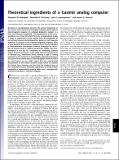| dc.contributor.author | Rodriguez, Alejandro W. | |
| dc.contributor.author | McCauley, Alexander Patrick | |
| dc.contributor.author | Joannopoulos, John D. | |
| dc.contributor.author | Johnson, Steven G. | |
| dc.date.accessioned | 2013-09-03T14:37:09Z | |
| dc.date.available | 2013-09-03T14:37:09Z | |
| dc.date.issued | 2010-05 | |
| dc.date.submitted | 2010-03 | |
| dc.identifier.issn | 0027-8424 | |
| dc.identifier.issn | 1091-6490 | |
| dc.identifier.uri | http://hdl.handle.net/1721.1/80336 | |
| dc.description.abstract | We derive a correspondence between the contour integration of the Casimir stress tensor in the complex-frequency plane and the electromagnetic response of a physical dissipative medium in a finite real-frequency bandwidth. The consequences of this correspondence are at least threefold: First, the correspondence makes it easier to understand Casimir systems from the perspective of conventional classical electromagnetism, based on real-frequency responses, in contrast to the standard imaginary-frequency point of view based on Wick rotations. Second, it forms the starting point of finite-difference time-domain numerical techniques for calculation of Casimir forces in arbitrary geometries. Finally, this correspondence is also key to a technique for computing quantum Casimir forces at micrometer scales using antenna measurements at tabletop (e.g., centimeter) scales, forming a type of analog computer for the Casimir force. Superficially, relationships between the Casimir force and the classical electromagnetic Green’s function are well known, so one might expect that any experimental measurement of the Green’s function would suffice to calculate the Casimir force. However, we show that the standard forms of this relationship lead to infeasible experiments involving infinite bandwidth or exponentially growing fields, and a fundamentally different formulation is therefore required. | en_US |
| dc.description.sponsorship | Massachusetts Institute of Technology. Institute for Soldier Nanotechnologies (Contract W911NF-07-D-0004) | en_US |
| dc.description.sponsorship | United States. Dept. of Energy (Grant DE-FG02-97ER2530) | en_US |
| dc.description.sponsorship | Massachusetts Institute of Technology. James H. Ferry Fund for Innovation in Research Education | en_US |
| dc.language.iso | en_US | |
| dc.publisher | National Academy of Sciences (U.S.) | en_US |
| dc.relation.isversionof | http://dx.doi.org/10.1073/pnas.1003894107 | en_US |
| dc.rights | Article is made available in accordance with the publisher's policy and may be subject to US copyright law. Please refer to the publisher's site for terms of use. | en_US |
| dc.source | PNAS | en_US |
| dc.title | Theoretical ingredients of a Casimir analog computer | en_US |
| dc.type | Article | en_US |
| dc.identifier.citation | Rodriguez, A. W., A. P. McCauley, J. D. Joannopoulos, and S. G. Johnson. “Theoretical ingredients of a Casimir analog computer.” Proceedings of the National Academy of Sciences 107, no. 21 (May 25, 2010): 9531-9536. | en_US |
| dc.contributor.department | Massachusetts Institute of Technology. Institute for Soldier Nanotechnologies | en_US |
| dc.contributor.department | Massachusetts Institute of Technology. Department of Mathematics | en_US |
| dc.contributor.department | Massachusetts Institute of Technology. Department of Physics | en_US |
| dc.contributor.mitauthor | Rodriguez, Alejandro W. | en_US |
| dc.contributor.mitauthor | McCauley, Alexander Patrick | en_US |
| dc.contributor.mitauthor | Joannopoulos, John D. | en_US |
| dc.contributor.mitauthor | Johnson, Steven G. | en_US |
| dc.relation.journal | Proceedings of the National Academy of Sciences of the United States of America | en_US |
| dc.eprint.version | Final published version | en_US |
| dc.type.uri | http://purl.org/eprint/type/JournalArticle | en_US |
| eprint.status | http://purl.org/eprint/status/PeerReviewed | en_US |
| dspace.orderedauthors | Rodriguez, A. W.; McCauley, A. P.; Joannopoulos, J. D.; Johnson, S. G. | en_US |
| dc.identifier.orcid | https://orcid.org/0000-0001-7327-4967 | |
| dc.identifier.orcid | https://orcid.org/0000-0002-7244-3682 | |
| dspace.mitauthor.error | true | |
| mit.license | PUBLISHER_POLICY | en_US |
| mit.metadata.status | Complete | |
